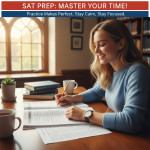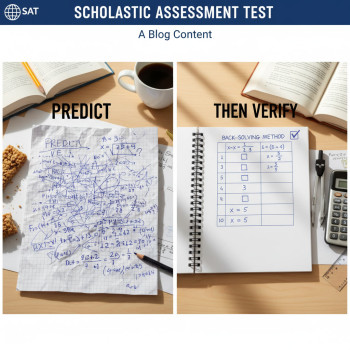Why the Library Is an Unsung Superpower for Digital SAT Prep
Walk into a library and you’ll notice the same quiet promise: space, resources, and a rhythm that nudges focus. For many students preparing for the Digital SAT, a library does more than hold books — it provides structure, official practice resources, and a low-cost environment to build habits that stick. Whether you’re a morning person who thrives on early silence, or a night owl using a study carrel, the library is neutral ground for progress.
In this blog we’ll map out exactly how to use libraries effectively for Digital SAT prep — from choosing the right time slot to running full-length Bluebook practice tests, building a weekly study plan, leveraging library resources, and integrating targeted support like Sparkl’s personalized tutoring when you want a tailored boost. Expect practical examples, a sample study plan, and a few mindset nudges to keep motivation high.
First Things First: What to Bring to the Library for Digital SAT Prep
Pack light but smart. A little preparation before you arrive turns a good study session into a productive one.
- Device and charger (confirm library Wi‑Fi or bring offline materials). If you’re practicing in Bluebook, check device compatibility and bring any required adapters or a mouse if you prefer.
- Headphones (noise-cancelling if possible) for focus and for listening to explanatory videos or audio vocab resources.
- Printed practice tests and answer sheets — many official digital practice tests can be previewed in-app but having PDFs for scratch work helps.
- Notebook and pens for active note-taking, error logs, and quick math work.
- Highlighters and sticky tabs for marking strategy notes or practice-test sections you’ll revisit.
- Water and a light snack — keep energy steady without heavy meals that make you drowsy.

Choose the Right Library Space and Time
Not all library visits are equal. The goal is to pick a setup that mirrors the focus you’ll need on test day and that fits the activity you’re doing.
- Silent study rooms — Best for full-length practice tests and intense focus sessions; reserve if the library allows.
- Group study rooms — Use these for collaborative sessions: peer review of essays, group vocabulary games, or timed peer-quizzes.
- Open reading areas — Good for light review, flashcards, and watching tutorial videos.
- After-hours access — If your library offers late hours, slot your most demanding work for the time when it’s quietest and you’re most alert.
Example: If you plan a full Bluebook practice test (which simulates the adaptive digital experience), reserve a silent study room for a morning slot when your energy is highest — and treat it like test day: no phone, limited breaks, and timed sections.
How to Structure a Library-Based Weekly SAT Study Plan
A focused weekly rhythm beats random, sporadic studying. Here’s a sample four-week block you can repeat, modify, or compress depending on your test date.
| Day | Focus (1.5–3 hours) | Why It Works |
|---|---|---|
| Monday | Reading & Writing practice (timed sections + review) | Start the week with comprehension and grammar — consistent gains in evidence-based reading. |
| Tuesday | Targeted Math practice (problem sets & concept review) | Focused math drills build procedural fluency and confidence. |
| Wednesday | Skill work + Khan Academy practice (adaptive questions) | Midweek skill sharpening keeps momentum; Khan Academy tailors practice to weak spots. |
| Thursday | Vocabulary & essay techniques (if applicable) | Short, active vocabulary practice and essay planning strategies. |
| Friday | Short review + light quiz (30–60 minutes) | End the weekday cycle with a light check-in; prevents burnout. |
| Saturday | Full-length Bluebook practice test (simulate test day) | Essential for pacing, endurance, and adapting to the digital format. |
| Sunday | Score review + error log analysis | Review is where improvement happens: identify patterns and plan next week’s focus. |
Tip: If Saturdays are busy, run your practice test on Sunday morning. The key is consistent full-length practice under realistic conditions.
Run Official Practice Tests in the Library: A Step-by-Step
Official practice tests are your best measure of progress because they reflect format and question style. Here’s how to run them in the library efficiently.
- Reserve a quiet room for a 3–4 hour window (full-length digital practice tests include timed sections and scores).
- Bring a ready device and make sure battery and software meet Bluebook requirements — many libraries have computers, but confirm beforehand.
- Simulate test-day rules: no phone, timed breaks, and practice with the same pacing strategies you plan to use on test day.
- After the test, spend at least 60–90 minutes reviewing every missed question: understand why the right answer is right and why your choice was tempting.
Example workflow: Take the test early in the day. Immediately afterwards, eat a light snack, then return to the same library room and run a targeted review session focusing on the toughest question types you encountered.
Using Library Resources That Many Students Overlook
Public and school libraries often offer more than books. Explore these underused resources:
- Subscription databases — Journals and magazines that improve reading comprehension with real-world texts.
- Practice test printouts — Libraries can print official PDFs so you can practice with paper scratch work if you prefer mixed-format revision.
- Librarian assistance — Ask about study rooms, scheduled quiet hours, or recommended research materials for evidence-based writing practice.
- Workshops and tutoring programs — Some libraries host free or low-cost test-prep events or partner with local tutors.
- Study groups and bulletin boards — Post or join study groups to practice verbal sections or peer-review essays.
If your library has a research librarian, they can suggest nonfiction titles and periodicals matched to higher-level reading passages, which is a subtle but effective way to broaden reading stamina and vocabulary.
Active Study Techniques to Use in the Library
Passive reading won’t move the score needle. Replace passive strategies with active techniques that map to how the SAT evaluates skills.
- Interleaved practice — Mix reading, writing, and math problems rather than blocking all one type. This enhances long-term retention.
- Spaced repetition — Use flashcards for vocabulary and slowly increase intervals between reviews.
- Error logging — Maintain a dedicated notebook in the library where you record each missed question, the reason for the mistake, and a targeted correction.
- Self-explanation — After solving a problem, narrate (silently or as notes) why each step is valid — this deepens conceptual understanding.
- Timed mini-bursts — Do 25–40 minute focused sprints with 5–10 minute breaks (Pomodoro-style) to build sustained concentration.
How to Use Peer and Librarian Support Without Losing Focus
Study partnerships and librarian check-ins can be powerful when structured correctly.
- Form a study duo for weekly 60-minute library sessions: 30 minutes independent practice, 30 minutes explanation and discussion.
- Use group rooms for timed vocabulary quizzes, then swap feedback for clarity and memory reinforcement.
- Schedule brief librarian consultations to locate primary-source articles or to request specific materials that match the reading level of SAT passages.
When to Bring in Personalized Help: Sparkl’s Role in Your Library Routine
Self-study in a library is powerful, but targeted support accelerates improvement. If you stall on certain question types or want an optimized study plan, it’s natural to add tutoring. Sparkl’s personalized tutoring fits naturally into a library routine because it offers 1-on-1 guidance, tailored study plans, expert tutors, and AI-driven insights that can analyze your error logs and suggest precisely which sections to focus on during your next library session.
Example: After three full-length practice tests and a growing error log highlighting weak algebraic structure questions, a Sparkl tutor can design three library sessions focused solely on those themes — blending explanation, scaffolded practice, and homework to complete between visits.
How to Track Progress: Simple Metrics to Use at the Library
Progress matters most when measured. Use library time to collect reliable metrics.
- Full-length practice test scores (use Bluebook or an official PDF). Record total score and section breakdowns.
- Question-type accuracy (e.g., Data Interpretation 80%, Heart of the Passage 60%).
- Response time averages for reading passages and math problems.
- Error-log categories: careless error, timing, concept gap, misreading question.
Below is a sample tracking table you can copy into your notebook and update after each test:
| Test Date | Total Score | Math | Reading & Writing | Top 3 Weak Areas | Next Week Focus |
|---|---|---|---|---|---|
| 2025-10-04 | 1200 | 620 | 580 | Algebra II, Sentence Structure, Passage pacing | Timed algebra drills, grammar rules, 1 full practice test |
Addressing Common Library Study Roadblocks
Even with the best intentions, studiers hit snags. Here’s how to handle typical library pitfalls.
- Noise or interruptions — Keep a short playlist of focus music or use noise-cancelling headphones. If interruptions persist, move to another floor or reserve a room.
- Access to digital tools — If Bluebook or other apps are blocked on public computers, bring your own device or download practice PDFs in advance.
- Fatigue — Shorten sessions, add more frequent breaks, or switch activities (e.g., from math to a light reading passage) to reset energy.
- Feeling stuck on a concept — Use the library’s nonfiction resources, ask a librarian for textbooks or guidebooks on the subject, or book a short session with a Sparkl tutor for targeted help.

Test Day Simulation: Make the Library Your Rehearsal Space
Rehearsal reduces anxiety. Use a library session to simulate test day:
- Install Bluebook and run the test on the same type of device you’ll use on test day.
- Follow official timing rules and use only approved tools (no phones).
- Take the same kind of breaks you’ll have on test day and practice returning to work quickly afterward.
- Dress comfortably as you would on test day and bring the same snacks to see how they affect your energy.
After the simulation, review your score report and error log in the library. Plan two targeted sessions that address the top three weaknesses you discovered.
Putting It All Together: A Full Library Session Example
Here’s a realistic 3-hour library session that blends practice and review.
- 0:00–0:10 — Setup: boot device, open Bluebook or PDF, gather materials, brief mindfulness/intent setting.
- 0:10–1:20 — Timed Math practice (two sections or focused problem sets) using Pomodoro bursts.
- 1:20–1:30 — Short break: walk, hydrate, quick stretch.
- 1:30–2:30 — Reading & Writing timed passage(s), then immediate review of every missed question.
- 2:30–3:00 — Error-log update and planning: note 2–3 concrete actions to fix recurring errors before your next library visit.
Repeat this template across the week with variation: swap in a full practice test on Saturday, or bring a Sparkl tutor for a 60–90 minute targeted session to accelerate improvement on stubborn areas.
Final Thoughts: Make the Library a Growth Engine, Not Just a Study Spot
Libraries are more than quiet rooms; they’re ecosystems that support deep work, access to official practice materials, and community resources that make real progress possible. Use them intentionally: schedule, simulate test day, keep meticulous error logs, and treat practice tests like experiments you analyze and iterate on.
If you find gaps that self-study can’t bridge, consider adding targeted support such as Sparkl’s personalized tutoring — it can integrate seamlessly with your library sessions through tailored plans, one-on-one coaching, and AI-driven insights that turn your error logs into a roadmap for faster gains.
At the end of the day, the best library strategy is the one you stick to. Make a plan, iterate often, and keep your study sessions active and focused. Libraries give you the quiet and the tools — you bring the curiosity and discipline. Combine them and you’ll walk into test day calm, practiced, and ready.


















No Comments
Leave a comment Cancel